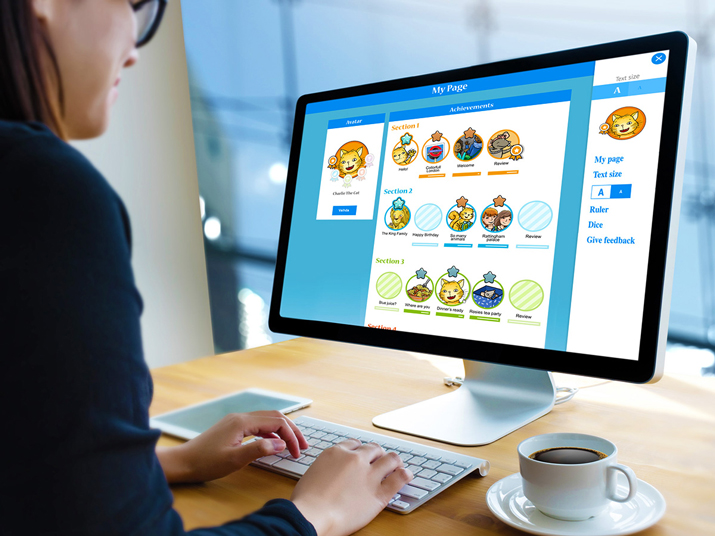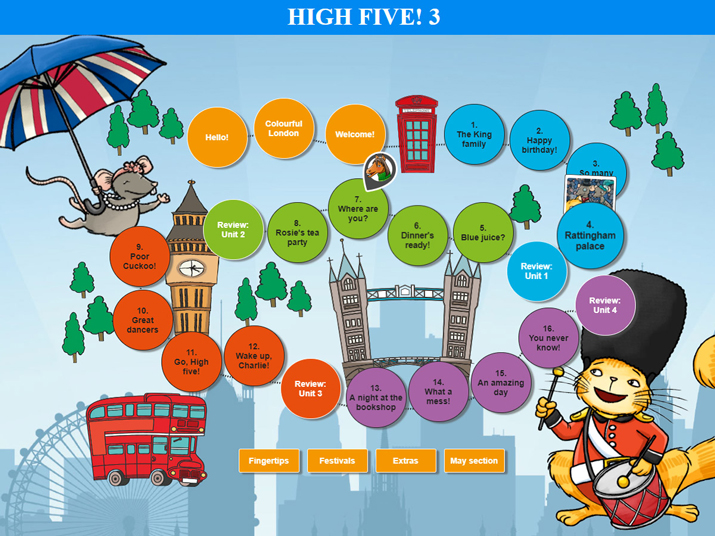
In the Gamification I article we looked into some lessons educational publishers can learn from learning games and the things worth considering when thinking about gamification. We are proud to continue the series by presenting some of the gamification functionalities that Cloubi 2 currently offers.
Let’s start with avatars, or game characters, and look at one of our favorite examples of gamified materials created with Cloubi, High five!, a hybrid ebook for primary school English published by Otava Publishing Company.

In High five! even the navigation is game-like: the ebook uses a customized gameboard navigation menu created by Ubiikki.
What is an avatar?
Avatars can be described as profile images that can have different functions within a game or, in our case, a learning material. They can be a great way to motivate learners: High five! lets students choose their favorite character from the book series and set it as their avatar. Adding avatars to a Cloubi product will make them appear in several places within the content.
First of all, the student chooses his/her avatar when accessing the material for the first time. They also have the option to change the avatar’s name through this dialogue or by visiting their own user page.
Students can choose an avatar when entering the product. In High five! the avatar serves as a bookmark in the navigation menu.
The avatar is also displayed and used in the product navigation, where it serves as a bookmark showing which part of the material the student has most recently accessed.
What makes a good avatar?
One of the lessons from learning games described in the last issue was that everything in a game has to make sense. This is of course true for game characters as well. When designing a new product that uses gamification, it is therefore worth thinking about what kinds of characters you want to include. What would the preferences be for students of a certain age? For instance, your avatars could be animals if the product is for very young children, or a diverse set of interesting faces for older students. Also consider what kinds of characters fit the subject: How about Einstein or Marie Curie avatars for a science product? Or the faces of famous presidents or other influential men and women for history or social sciences materials?
In addition, avatars are a great way to motivate students if their appearance changes or is enhanced according to progress within the content for example by adding badges or other achievements linked to the avatar. For instance, a scientist avatar might gain some science tools, an animal might earn fun gimmicks like hats or sunglasses, etc. The possibilities are endless!

A peek into the future of Cloubi’s gamification options: New gimmicks are added as the student progresses through the product.
Adding avatars to Cloubi products
Avatars (as well as some other fun gamification features) can be added through the Gamification Editor. Go to Gamification in the editing view of your product in order to activate the editor:

Click the blue button in order to start adding avatars.
After this, the menu for adding avatars becomes visible. Upload your avatars, give them a name and, voilà!, you will see all the avatars you have added in a listing:
Add a nice variety of avatars.
Clicking Preview in the upper right corner will show you the student’s view, as seen in image 2 above. The student can always change his or her avatar (and the character’s name) by accessing My page through the sidebar menu.
Changing the avatar’s name.
Avatars are just one of the simplest form of gamification features Cloubi currently offers. Stay tuned: more features will be introduced in the coming issues!


